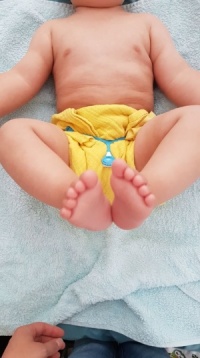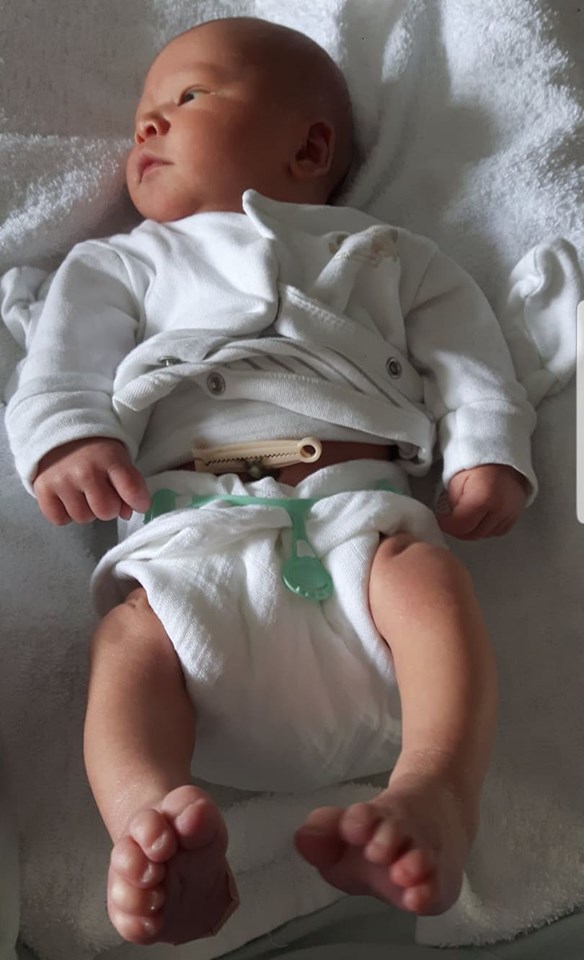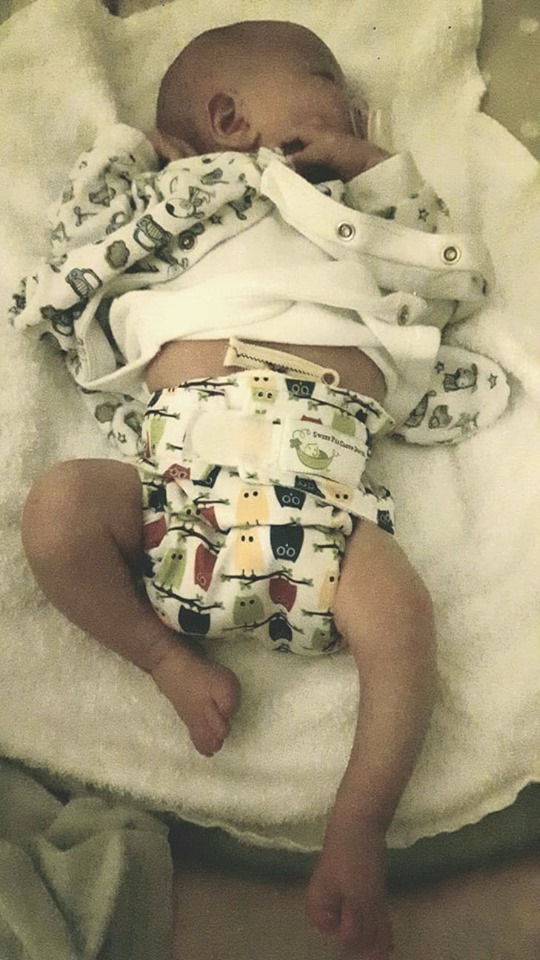Tips for Using Cloth Nappies for Newborns
CONGRATULATIONS!! You are expecting your bonnie bundle of joy. Whether you are thinking about having a baby or are pregnant and waiting, it’s best to be prepared if want to use cloth from birth. When I was pregnant, I wanted to know everything, I mean EVERYTHING before I met my little precious one - so make a cup of tea and get stuck in, here is everything you need to know about cloth nappying your new baby. At the end there will be a list of things you might need for your set up.
Think about setting a budget:
Everybody’s circumstances are different but that doesn’t mean they are better or worse than yours. There are no rules stated anywhere in the handbook of cloth nappies (gosh I wish there was one of those when I started out) to say that you absolutely have to have all the nappies you need straight away. Take your time to figure out your finances and budget how much you want to spend or can spend on your investment. I say investment because that is what it is. You are investing in nappies for your current baby plus any subsequent babies you may have in the future. As much as I wish it weren’t true, newborns don’t stay newborns for very long so there is no need to go mad buying a hundred newborn nappies when they will outgrow them within a few weeks. It’s a good idea to have a mix of newborn and birth to potty nappies in your stash.
A few options to consider for your budget is whether you would like to buy in bulk or spread out the cost over the next coming weeks or months. When buying in bulk it can sometimes be beneficial to wait for special deals close to Real Nappy Week, usually in April, or near Black Friday in November. Alternatively you can buy one nappy a week or one a month until D-Day and build up your stash slowly. Another way of keeping your costs low is by buying preloved nappies – usually on facebook groups or sale websites. Look out for abbreviations such as EUC (Excellent Used Condition) and VGUC (Very Good Used Condition). Most people are honest and will tell you if there are any stains on the nappies.You can find some real gems but be quick because they get snapped up quickly.
No Pressure:
I say this to every new parent out there. Please do not put pressure on yourself to use cloth straight away if you are not feeling up to it. The single most important thing is that you heal, stay hydrated, rest and get to know your new baby and your new family dynamic. Stay in bed if you need to, for however long you need to. Smell your newborn baby’s head, count their fingers and toes a hundred times, go searching for cute little birth marks, cradle their cushy dimply bum, marvel in the absolute wonderment of how this baby came to be in your arms. Cry. Cry with happiness, cry with sadness, when the need arises. The best advice my mother gave me when I had my first baby was just to ride the emotions and let it all out as it came. And it came in waves. I cried and cried and cried at everything. Sometimes it was from loving my baby too much, sometimes not enough. Sometimes it lasted for a few minutes, sometimes longer. Just don’t keep it bottled up, it needs to be released.The washing of cloth nappies can wait until you are healed and feeling up to it both mentally and physically.Mum guilt is real but it has no power if you do not let it. Use those disposables until you no longer need to.
Which Newborn Nappies?
In my opinion, hands down the best nappies for newborn babies are muslins and a waterproof wrap. If you are thinking of muslins as in burp cloths then you would be correct. I’m not talking about the same kind of quality you would expect from a packet of muslins from Penney’s but certainly something similar. The brand I used was MuslinZ. These are typically cotton or organic cotton muslin squares that you fold into the shape of a nappy, fasten with a nappy fastener or safety pin and cover with a waterproof wrap (like the Best Bottom wraps available here). There are a plethora of YouTube videos on different folding techniques that can be easily learned with a little practice. I found it really exciting practicing different folds before my baby arrived and I involved my eldest too to make him feel helpful and included.
Gone are the days of accidently stabbing your baby with a safety pin. Hello Nappi Nippas! These wonderful inventions grab onto the fabric easily to keep the nappy in place and ensure a good fit. Top Tip for waterproof wraps: choose a newborn wrap that has a dip in the front to allow the umbilical cord to dry out.
There are some lovely newborn pocket nappies and all in ones but again you don’t need too many of these as baby will be fast to grow out of them. Soft bamboo or cotton shaped/ fitted nappies are perfect for night time changes when you are too bleary eyed to fold muslins.

How Many Nappies?
Newborns need frequent nappy changes due to the amount of poop that comes from their tiny bodies and to prevent nappy rash (more about that below). A ballpark for the amount of nappies for newborns is 30. This is why muslins are so great because you get 12 in one pack. A couple of packs of these plus a few fitted /shaped nappies for ease is a great combo. Or mix up the ratios with one pack of muslins, 6 wraps, a few pocket nappies and a few fitted nappies. I never recommend having an entire stash of the same type or brand of nappy just in case they don’t suit your baby. Every baby shape is different and what suits one baby might not suit another. When it comes to waterproof covers/wraps, you will need one for every four nappies as you don’t need to change these at every bum nappy change. If there is no poop on them simply wipe down and reuse.
Liners
Using liners in your nappies can often minimize staining and protect nappies from barrier creams. There are two main types, disposable liners and fleece liners. Disposable liners are often made from paper which you throw away into you bin once it is soiled. I didn’t use disposable liners in the beginning because the poop was so runny it just went all over the nappy regardless. Please note that even if a brand of liners or wipes state that they are flushable, they should never be flushed down the toilet as they causes blockages.
Fleece liners are made from polyester fleece. They have no absorbency and their function is to draw moisture down into the absorbent part of the nappy and leave baby’s bum feeling dry. If using standard pharmacy oil based nappy creams then you will need to use a liner as barrier creams can affect the absorbency of your nappies. There are a number of natural nappy creams that are cloth nappy friendly including Weleda Calendula Nappy Cream or good ole plain coconut oil.
Nappy Rash
Newborn skin is very delicate and may be prone to nappy rash in the beginning whether you are using disposable nappies or not. The most common cause of nappy rash is when poo or wee is next to baby’s skin for too long and causes irritation. Be sure to change your baby frequently and as soon as possible after they have pooped to avoid nappy rash. I believe most newborn babies suffer with some nappy rash in the beginning as their skin adjusts to being urinated and pooped on. When my second was born, we put him in cloth as soon as we got home from the hospital and he developed a rash with white spots on one side of his groin area. (the side his willy was pointing and weeing). The doctor said it was a yeast infection and to put a small amount of Canesten cream on it. I did and it didn’t work. I tried more creams and coconut oil but to no avail. I tried putting him in an eco friendly disposable nappy, nothing worked. I became obsessed with trying to find something natural to get rid of it. I came across a blog for curing eczema with apple cider vinegar and I gave it a shot. I can’t find the link now but it suggested 1/2 cup of ACV in baby’s bath or 1 tablespoon in 1 cup of water and use as a wipes solution when changing their nappy. I bathed him every second day in the ACV mix and used the wipes solution at every change with lots of nappy free time. I put no cream or oils on and just let him dry naturally. I was amazed by how much the redness had reduced even after the first bath. He went from being red raw to a soft pink within minutes. I kept this up for about a week by which time he was all healed and never had nappy rash again.
Please NEVER put neat apple cider vinegar on baby’s skin. I am not a doctor, this solution worked for us but if you feel like your baby is in discomfort please consult your GP.
If baby is getting bad rash all over their nappy area, you may need to review your wash routine and use more detergent or a hotter wash.
Ensuring a Good Fit
Making sure you have a good fit is essential for all cloth nappies no matter the age of baby, however it is vital during the newborn stage in order to contain all those poo explosions or “poonamis” as they are often referred to. Newborn poop is runny and escapes easily with the same amount of force as a rocket blasting into space. I still don’t know how this is possible for a newborn baby but it is. I used disposables on my first son and I lost count of the amount of “up the back” poo explosions we had. I was doing so much washing even then. When we had my second, I can honestly say that we did not have a single poonami! Everything was contained inside the nappy and any poop that escaped was contained by the wrap.
To ensure a good fit no matter what type of nappy system to use, make sure the nappy is snug but not too tight. Check for any gaps around the legs because this is most likely where the leakage happens. A small gap at the front is ok because you want baby to have space for their beautiful belly when sat up for burping. If using fleece liners, make sure there is no fleece sticking out at the back, front or around the legs as this will wick wee onto their clothing.

What do I do with the poop??
Baby has done a poop in their lovely cloth nappy! What do you do with the nappy? Boil it? Soak it? Nope! There’s no need for those extra steps anymore thank goodness! Breastfed baby poo is water soluble and usually very runny. There is no need to do anything with it other than pop it inside your nappy storage and wait for wash day. It will dissolve in your washing machine, attach itself to the detergent and wash away, leaving your nappies clean! As mention above, breastfed poop can cause staining but this does not mean that your nappy isn’t clean. Simply hang on the line in daylight and allow the power of the sun to naturally bleach out the stain. This works also on a cloudy day, it just might take a little longer. Rainy day? Pop them on your windowsill inside.
If your baby is formula fed sometimes the consistency can be a little more solid. If solid enough to plop down the toilet please do so before putting the nappy in the washing machine. If a little squidgy and not “ploppable”, rinse it with your shower head on full power over a bucket, and empty the bucket contents down the toilet. Wash nappy as usual.
So as a general rule, very runny can go straight into storage, solid can go down the toilet and semi solid can be rinsed off with the shower or wiped down with some loo roll.
Cloth nappies for infants should be washed at 60 degrees for the first 3 months to ensure all bacteria is killed. After this period it is safe to wash at 40 degrees or stick with 60 if you prefer.

So there you have it. Some tips for using cloth on a newborn baby. If you have any more questions please don’t hesitate to contact me through Facebook at https://www.facebook.com/thenappycamper/ or Instagram at https://www.instagram.com/nappycamper/ or email me at info@thenappycamper.ie
Enjoy your new little baby and your new exciting journey.
Things you may need for cloth nappying a newborn baby:
- Dirty Nappy Storage (Bucket with mesh laundry bag or large hanging wetbag)
- Clean nappy storage (box, shelves, drawers, whatever suits you)
- Medium sized wetbag for your changing bag
- 24 to 30 nappies (mix of types and brands)
- Wraps for muslins or fitteds (dipped elastic at front for umbilical cord to breathe)
- Wipes and a lunchbox to store them in
- Liners
- Nappi Fasteners (if using muslins)
- Boosters for extra absorbency as baby grows (but not essential straight away)
- Nappy cream (I recommend Weleda Calendula)
- At least one baby J
